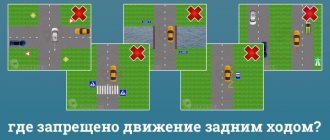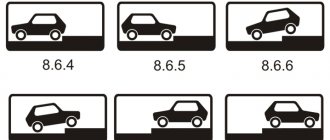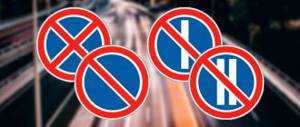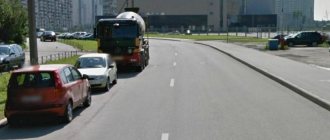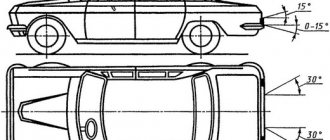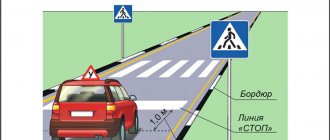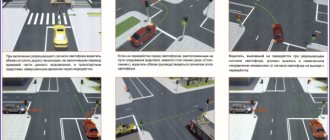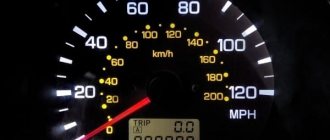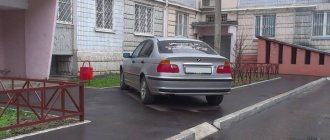Training in driving schools is now streamlined, and in a short period of time it is very difficult to master all the subtleties of driving, including learning how to properly reverse park between cars.
Beginners often lack parking skills. Without it, it will be very difficult in the city. In any city there is often a shortage of parking spaces and space is limited. Novice drivers may even experience fear. Incorrect actions can lead to accidents. And even if a car enthusiast knows how to park in front, parking in reverse can be a big problem for most. Let's look at the basic schemes, rules, and nuances of this process.
These tips will be very useful for those who have recently gotten behind the wheel of their own car.
[su_divider top=»no» style=»double» divider_color=»#238516" size=»6" margin=»5"]
Current Auto News
[su_cu[su_custom_gallery source=»posts: recent» limit=»3" link=»post» target=»blank» width=»190" height=»190" title=»always»]p>[su_divider [su_divider top= "no" style="double" divider_color="#238516" size="6" margin="5"]how to master reversing?
Maneuvering in reverse in the city is quite dangerous. Often the danger is that the driver does not receive enough information about people on the road or other objects that are behind the car. That is why, to confidently move backwards, you need to adjust the side mirrors. Experienced car enthusiasts recommend adjusting the mirrors so that 15% of the rear fenders can be seen, and the rest is an overview of the situation.
You need to make sure that the mirrors are not skewed either up or down. But you still have to tilt the side mirrors down. Reversing parking next to a curb is impossible without tilting the mirror correctly. Don't trust the mirror Experienced drivers confidently say that you shouldn't rely too much on the mirror. Especially you should not trust the salon curved one.
They distort too much the real distances to objects or obstacles. Naturally, this fact prevents a beginner from parking correctly. To fully control the movement and situation behind your car, it is better to turn around and watch through the rear window. This way you can get a much larger amount of information.
In theory, driving backwards is very easy. If you turn the steering wheel to the right, the car will turn to the right, and vice versa. When a novice car enthusiast leaves the walls of the racetrack, and there is no longer an experienced instructor nearby, this knowledge disappears somewhere. To prevent parking a car in reverse from leading to emergency situations, you need to master the skill of moving slowly in reverse. If this is not the case, then you do not need to fully release the clutch pedal. Here it is recommended to work more impulsively.
If you need to move, release the pedal; if you want to start rolling, press the clutch pedal to the floor. Don't put too much pressure on the gas. Some novice drivers, who receive important knowledge and driving lessons in various driving schools, learn to drive in reverse only using the clutch. No gas at all. It is not right.
In real conditions, situations are different. Regarding the steering, you can also note that for beginners it is better to use the rear window as a windshield. So, just turn the body back. Turning the steering wheel will turn the rear of the car to the right, and vice versa. It is important to understand that absolutely any car is more maneuverable when in reverse. There are sharper turning angles here. It is important not to lose the position of the steering wheel, in which the car drives straight. This knowledge and skills are very important.
Without them, you won't be able to park correctly. This can lead to ridiculous accidents, scratched foreign cars and various troubles. Reverse parking for beginners
If you want to improve your skills or learn how to park backwards from scratch, then you can’t do without training. A special platform is suitable for this. There may already be markings on it, but if not, then you can place pegs or stands on the site. They play the role of other machines. The distance between these “cars” should be twice the length of your car. Pegs are not only a great training method. It is also cost effective.
If your car collides with a pillar, it is much cheaper than colliding with an expensive foreign car.
Method 2: Perpendicular parking on the left
If you like the parking space located on the left in the direction of travel, you can do the following:
- find a place to turn around, after which the parking “cell” will be on the right side (and then you already know what to do);
- wait for oncoming cars to pass and park in the place you like in reverse.
Advice. If you decide to park on the left, you must do so calmly but quickly. The lengthy parking process blocks traffic and annoys other drivers.
Step 1: Select a parking space. Analyze oncoming traffic in the parking lot. Turn on your left turn signal, which will alert other road users that you plan to park.
When there are no oncoming cars, move to the left side of the lane and stay about 1 meter away from the cars parked on the left.
Step 2: Select the appropriate position. Stop your car the moment your rear bumper aligns with the corner of the parked car's bumper.
Step 3. Engage reverse gear and begin parking between cars. Turn the steering wheel all the way to the left, and then back to the right about half a turn.
Step 4: Continue to park slowly. Check your left rearview mirror to maintain a safe distance between the rear bumper and the vehicle next to you.
Constantly check your surroundings through the right and interior mirrors to ensure that you do not crash into other vehicles or obstacles.
Step 5: Complete the drive in reverse gear. When your vehicle is parallel to other vehicles, align the wheels by turning the steering wheel to its original position.
Continue to drive slowly in reverse until there is 15-30 cm between the rear bumper and obstacles or markings.
Step 6: Set the parking brake. Assess the distance to vehicles to your sides and behind you. If you drive too close to one of the cars and this makes it difficult to get in/out, you need to correct the position of the car.
Feel the dimensions when parking
Parking in reverse without being aware of your dimensions is almost impossible. It is developed with experience, and those drivers who perfectly understand the size of their car have worked on it for a couple of years. This cannot be taught, you just have to try. How to park correctly? When a motorist tries to park somewhere, it is necessary to ensure the correct division of attention.
When reversing, it is important not only to turn your head in all directions, but also to look in the mirrors. Just looking back is great, but everything that is below the level is hidden from view. Mirrors allow you to obtain more accurate information about the obstacle. This way you can control the situation in every sense, and the car will be more maneuverable. When reversing, let it be parking in reverse between two cars, you must take into account that those cars with rear-wheel drive have a minimum turning radius.
For all-wheel drive vehicles this figure is maximum. When planning to park, mentally draw a trajectory of movement, and then you will understand much faster how and what to do.
Common mistakes when rear parking
Often, beginners make several mistakes when parking backwards between cars.
Here is their main list:
- Hurry
As they say, if you hurry, you will make people laugh. Often you want to park your car quickly and run to run errands or go home; too much haste can backfire. You can, at a minimum, park your car poorly, creating an emergency situation for other car owners, or, even worse, scratch someone else’s car.
- Do not control the situation 360 degrees
When reversing, you can easily look at one mirror and not pay attention to the other. Or not noticing that you have pressed the right or left edge of the car too close to your neighbor in the parking lot.
- Be nervous and worry
This is the psychology of driving, but there is no escape from it. You may start to twitch because someone is standing and watching. Or beeps to hurry up. And if you lose your head, you can easily make the wrong move.
Reverse parking
Parallel parking in reverse is one of the typical ones. This scheme is really complicated. Here you need to take into account literally every little detail.
When preparing for a maneuver, you need to align yourself with the cars next to your place. The distance between your car and another should not be more than 1.5 m.
First of all, position your car parallel to the car that will be in front after the maneuver.
[su_divider top=»[su_divider top=»no» style=»double» divider_color=»#238516" size=»6" margin=»5"]line Autonews
[su_custom_gallery source[su_custom_gallery source=»taxonomy: post_tag/1100,1319,1524" limit="3" link="post" target="blank" width="190" height="190" title="always"]" no" style="d[su_divider top="no" style="double" divider_color="#238516" size="6" margin="5"] of your car should be as clearly as possible opposite the wheels of this car.
It is quite difficult to understand how to park in reverse. The diagram will help you navigate better.
Now turn the steering wheel all the way to the right and carefully start moving backwards. In this case, the situation needs to be controlled in the left mirror. Continue driving until you see the headlight of a car behind you. Then you can set the steering wheel straight and drive like this until you see the rear of the car in front of you.
Now you can turn the steering wheel to the left while continuing to move. The car will park parallel to the curb. When parallel parking in reverse, pay close attention to the front of your car. The important thing here is not to damage the object that is in front. Then all that remains is to level the car. This is to make it easier for you to leave your location.
It is quite possible to learn how to park using this scheme. The main thing is to understand the procedure and practice the theory in practice. If something doesn't work out for you, don't be upset. After all, parallel parking in reverse for beginners is not so easy.
Parallel parking in front
Front parking is the rarest parking method, but it is widely used by many drivers when entering a parking lot from a busy road.
You can also parallel park in front, although only if free space allows.
To do this, you need to align with a standing car, and then turn slightly to the left.
Next, you need to drive a little forward so that the front of the parked car is level with the middle pillar of your doors, after which you can turn the wheels to the right and drive into a parking space.
When the curb is hidden behind the front of the car, the steering wheel is twisted to the left, and then, when the car is parallel to the curb, the wheels need to be aligned and stopped.
This parking method is not always possible due to the density of parked cars.
Parallel parking, forward and reverse
Channel Sergey Novokshonov
About rear perpendicular parking
This scheme is a method in which the car is installed parallel to other cars that are next to you, but also perpendicular to the curb. For those who do not find this method difficult, it will make it very easy to park and enter garages.
If you want perfect perpendicular parking in reverse, it's worth practicing again. You don’t have to look for a suitable site for this. Your garage is suitable as such. Try to drive carefully into and out of the garage. You should strive to perform all actions almost automatically. Many novice drivers prefer to use a pre-drawn diagram for this.
Video tips on how to park in reverse
Here is another selection of videos where you can additionally watch tricks on how you can learn how to park in reverse.
Parallel parking during the traffic police exam:
Exercise “Checking into the box” - parking in reverse to test for your license at the traffic police:
A special video for novice drivers on the intricacies and secrets of parking in a “pocket”:
Parallel parking with explanations from a female driving instructor:
Parallel parking in 3 stages (3D video):
Parking near the store:
Check-in to the garage:
Parking algorithm
Choose a suitable place where you will park your car, drive up to it. Your task is to park in reverse.
The scheme involves stopping about a meter from other parked cars. Next, draw a mental line.
It will start at the center of the rear wheel and end at the level of the seat.
When you connect it to another vertical line, you get a point. It should be somewhere around the rear wheel arch.
Mentally find the point on the marking where you will turn. Turn right and reverse gear.
When the line connects with the parking spot, turn the steering wheel one and a half turns. Move as slowly as possible.
It is important to feel the dimensions of your car. Head straight to the center of the parking lot. When you stand parallel to others, align the wheels.
Then move back further until you stand next to others.
Always look back and to the sides.
Also pay attention to mirrors.
Reverse parking between two cars or any other method requires concentration and attention, especially for beginners.
Also keep in mind that you will need to get out somehow.
Therefore, estimate the distance that is enough to open the doors.
Master this algorithm until everything comes out automatically. If you are not sure yet, buy parking sensors. This way you will protect yourself and other cars.
Such a scheme and skills will be very useful to you on the road. This is nothing more than parking in reverse between cars.
It's just that instead of other cars you have a garage. But the algorithm of actions is the same.
[su_divider top=»no» style=»double[su_divider top=»no» style=»double» divider_color=»#238516" size=»6" margin=»5"]news
[su_custom_gallery source=»taxonomy: post_t[su_custom_gallery source=»taxonomy: post_tag/996,1187,1067" limit=»3" link=»post» target=»blank» width=»190" height=»190" title= "always"]e" divider_colo[su_divider top="no" style="double" divider_color="#238516" size="6" margin="5"]90 degree angle
There is often a situation where you need to park backwards at 90 degrees. This happens in underground and surface parking lots, parking lots near business and shopping centers, as well as in courtyards. When entering the garage, the same technique is used.
In such cases, you can use the “old fashioned way” - turn your head, lean out of the car, or you can use a parking scheme.
Instructions and diagram of perpendicular parking
There are two options for parking in reverse.
Option 1. If there is free space in front of the cars
This parking option is carried out if the space in front of the cars allows this and there is room for a turn.
- Select a parking spot Make sure there is enough space between cars so you can easily enter.
- Take the “starting position” Stand so that the cars are to your right, and the nearest one is on the line “your right headlight - his left headlight.”
- Make a 90 degree turn to the left You need to turn left so that you are on a trajectory where you can reverse and position yourself exactly between the cars.
- Reverse Move backward until you reach the desired position. If necessary, move forward and backward by turning the steering wheel so that you stand level between the cars.
Here is the driving diagram for parking in reverse according to option 1.
Option 2. If there is no free space in front of the cars or it is extremely limited
This option will be useful for reversing parking in “cramped conditions” when there is little free space.
- Choose a parking place It is important to maintain distance. Focus on half a meter from the next car, so that both you and the driver of the neighboring car can safely open the doors without scratching the coating.
- Take the starting position for a reverse turn. Place the car perpendicular to the standing cars and stand slightly forward. It is important that the distance to the parked car is 40-50 centimeters.
- Turn the steering wheel all the way and get ready to move. If the parking space is on your right, turn the steering wheel all the way to the right, if on the left, then turn it to the left. Make sure in the mirrors that nothing will interfere with you. It would be a good idea to also turn on your hazard lights.
- Slowly move backward until the car is parallel between two neighboring cars. Check in the mirrors that you are accurately entering the turn; if not, drive forward and repeat the maneuver with a reserve for movement. Pay more attention to the left mirror.
- Align the steering wheel and drive back. When the car has driven between cars, continue driving with “straight wheels” straight back.
If you've timed everything correctly, you'll be in the perfect spot. If necessary, drive slightly forward and back up to position yourself evenly between the cars and leave room for the doors to open fully.
For convenience and understanding of parking mechanics, look at the diagram of option 2.
Video on how to park in reverse at 90 degrees
Learning direct parking
This is a very simple and necessary method in the city. Here the car is parked along something in a straight line. If you decide to park this way, you don't need to drive too close to the objects in front of you.
Also don't forget about the doors. Pay attention to obstacles near your doors. When parking straight ahead, approach the car in front of you as close as possible to 1.5 m. Then start moving towards the curb.
Before the front wheels reach the curb 0.5 m, turn the car to the left. Then level off. This requires precise control skills. Focus on the dimensions of the car in front of you.
Also consider safe departure.
How to learn to park when parallel parking in front?
Experienced motorists have repeatedly encountered situations where rear parking cannot be accomplished. Don't be afraid of such situations, as there is always the opportunity to park in front.
Just follow the following instructions:
- Stop the car by finding yourself in front of the car on the side, leveling your shoulders with the front bumper of the car standing next to you. Considering right-hand traffic, the vehicle will be on the right side of your car.
- Turn the steering wheel towards the parking lot and slowly continue moving forward until the car is parallel to the curb. Side mirrors will help you with this.
- Once the wheels are aligned, reverse.
